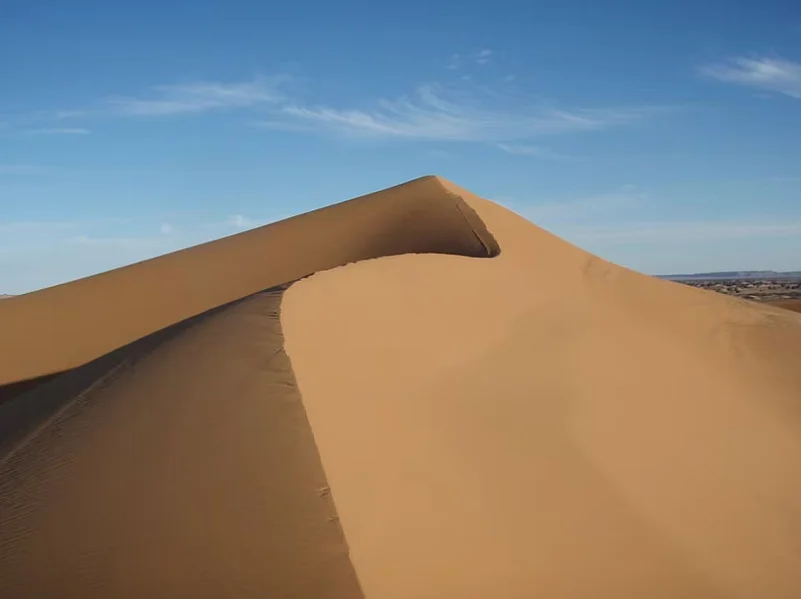Star dunes, which are roughly pyramid-shaped formations of sand reaching heights of up to 1,000 feet (300 meters), stand as remarkable features in the deserts. With arms extending outward from a central peak, they create a star-like impression when observed from above.
On Monday, scientists presented the first comprehensive analysis of a star dune, divulging insights into the internal composition of these geological phenomena. The study also sheds light on the timeline of their formation, indicating a relatively quicker process than anticipated, yet still evolving over numerous centuries.
The research centered on a star dune named Lala Lallia, located in eastern Morocco. Translating to "highest sacred point" in the local Berber language, this dune resides within the Sahara Desert, specifically in a small expanse of sand known as Erg Chebbi, approximately 3 miles (5 km) from the town of Merzouga, near the Algerian border.
Lala Lallia stands at a height of around 330 feet (100 meters) above the adjacent dunes, spanning approximately 2,300 feet (700 meters) in width. It encompasses an estimated 5-1/2 million metric tons of sand.

Utilizing ground-penetrating radar, researchers delved into the interior of the dune, while employing luminescence dating to ascertain the formation duration of Lala Lallia. This dating method hinges on the energy stored within the sand grains. Their findings revealed that Lala Lallia took approximately 900 years to form, accumulating an estimated 6,400 metric tons of sand annually as wind incessantly transports sand across the desert.
Star dunes, constituting just under 10% of Earth's desert dunes, reign as the tallest among them, eclipsing other varieties such as crescent-shaped barchan dunes and elongated linear dunes. Notably, they have been observed not only on Earth but also on Mars and Saturn's large moon, Titan.
Geographer Geoff Duller from Aberystwyth University in Wales, a co-author of the study published in the journal Scientific Reports, reminisced, "I first encountered star dunes in Namibia 20 years ago, and was instantly amazed at the size of them. I have a vivid memory of the long climb to the top, struggling up very loose sand in the heat of the day,"
"I find desert dunes very beautiful," Duller added. "The sight of the sinuous curves, and the way that the light and shadow changes with the sun mean that they always look different, whether that is in the cool of the morning, the midday sun or near sunset. The different colours of sand in different deserts are also very striking, with yellow, white, red and even black dunes in different parts of the world."
The researchers also determined that Lala Lallia is shifting westward at a rate of approximately 1.6 feet (0.5 meters) annually.
Despite the abundance of contemporary star dunes, only a solitary ancient specimen has been preserved as sandstone in the geological archives, dating back roughly 250 million years, discovered in Scotland. By elucidating their internal composition, the researchers believe their findings will aid geologists in identifying more sandstone remnants of ancient star dunes.

The ground-penetrating radar unveiled the stratified layers within the Lala Lallia dune, illustrating its gradual formation over time through the accumulation of sand. Additionally, it revealed resemblances between parts of its internal structure and other dune types.
"Star dunes are formed in areas with complex wind regimes, which means winds blowing from different directions, and net sand accumulation, points within the desert where big piles of sand can be blown around to form giant dunes," explained Charlie Bristow, a sedimentologist from Birkbeck University of London and co-author of the study.
Earth's largest star dunes are situated in the Badain Jaran Desert in western China. They are also present in various locations worldwide, including the Namib Sand Sea in Namibia, expansive sand seas in Algeria such as the Grand Erg Oriental and Grand Erg Occidental, and the Rub' al Khali in Saudi Arabia. In North America, Great Sand Dunes National Park in Colorado features a series of these remarkable formations.
"They form extraordinary and awe-inspiring landscapes," Bristow said. "From the ground they can be intimidating, mobile mountains of sand."


























